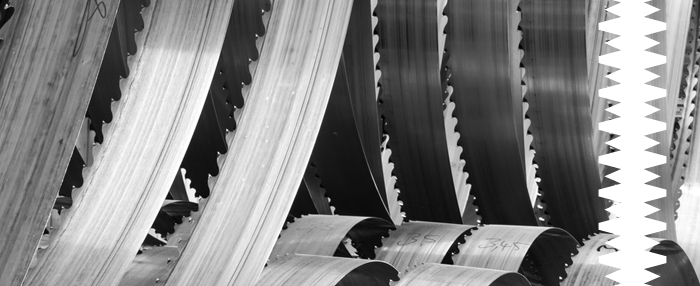Bandsaw Blades FAQs
Bandsaws are cutting machines with two or more large wheels providing the impetus for the bandsaw blades which are wound in a circular loop around them. The blade is threaded through an aperture in a level work surface positioned between the wheels.
The blade needs a certain level of tension to ensure it has enough resistance, known as beam strength, when you are sawing materials. If the tension is too slack, the blade won't cut straight and may even be derailed.
Some cutting machines are equipped with an automatic tension meter. Alternatively, there are portable tension gauges you can use. Experienced bandsaw operators often test the blade tension themselves - while the machine is safely unplugged of course! They usually push the blade slightly to the side and watch for how much it springs out of line. An average deflection of around one-quarter of an inch is usually favourable for cutting most materials.
At SawsUK, our three most popular, multi-purpose blades are bimetal blades, carbon steel blades and ground tooth blades.
You can also find S42 structural bandsaw blades which are designed for cutting things like structural beams. We also have a wide range of coated special blades for special applications.
Our bi-metal bandsaw blades are available in a range of widths and lengths. They have an edge of hardened cobalt steel that provides them with additional strength. They cut through all types of structural steel such as H-beams, angled sections, pipes and tubing.
You'll get the best performance from a sharp blade. Once it becomes dull it's not usually worth the time or expense of sharpening it. Bandsaw blades are generally very economical, making a new one a much better option.
Using the right type of blade for the type of material you need to cut is essential for achieving a clean, precise cut. It’s also important to use the correct type of blade for safety reasons. Our premium quality blades are manufactured to the highest specifications to provide reliable, high performance cutting. The materials they are made from usually make them suitable for particular sawing projects.
The width often depends on the material you are sawing. A wide blade usually has a greater beam strength and is generally more suitable for cutting thicker or harder materials. However, the width affects the radius when cutting curves.
Bandsaw blades are not literally folded, but they can be looped into smaller coils, making it easier to store them. Bandsaw beginners often find the flexible blade springs out of control whenever they try to fold or coil the blade.
At Saws UK, we use a simple technique that makes the process easy.
Tracking means keeping the blade aligned and securely attached to the bandsaw wheels. The blade needs to stay on track for your safety and for cutting straight. When the wheels of the machine are old or worn, they may not have a distinct ridge or crown, causing the blade to slip. The SawsUK bespoke service ensures a set of brand-new wheels perform at their peak.
In general, carbon steel blades are used to cut mild steels and other non-ferrous metals, plastics and wood. These blades are perfect for vertical band saw machines. Bimetal blades are usually used to cut all metals in tubing, profiles and small solids and are typically the best choice for manual / semi automatic machines and short blade lengths.
Ground tooth blades have high resilience particularly to heat, making them ideal for cutting large batches of metal such as steel, aluminium and copper. Carbide grit edge blades cut through almost any difficult or abrasive material, including titanium, fibreglass, compressed rubber and brick.
You can find out more about choosing the right blade for your requirements in our bandsaw blades buying guide.
It’s also essential to ensure that you use the right blade pitch with your bandsaw, as this will help you to make the most accurate and clean cuts.
The size of a bandsaw blade is determined by the diameter of the wheels your bandsaw has. At Saws UK, we manufacture blades in any size and any length. Please contact us on 0800 521 292 for technical advice and we will always advise on the best blade for the job.
At Saws UK, we manufacture all types of bandsaw blades in any size, any lengths.
Maintaining a sharp, effective bandsaw blade is often down to common sense. Use the correct type of tooth for the material and always clean the teeth after use. When setting up, make sure the tension is correct and the blade tracking is stable. When using a coolant, always follow the manufacturer's recommended guidelines.
If a bandsaw blade is not cutting straight in any direction is due to general maintenance not being undertaken. Please book your service with our Service department at Saws UK or call us for advice.
TPI stands for Teeth Per Inch. The distance is measured between teeth. Metal usually requires more teeth per inch, while wood cuts well with fewer teeth per inch.
To determine TPI of a blade, give us a call on 0800 521 292.
Consider the metal and its structure. Please follow our guidelines and measure cutting depth, material thickness and take a note of the shape.
Bandsaw blade width should ideally correspond to the diameter of the wheels. For instance, a wheel diameter between 18 inches and 24 inches should have a blade width of around 032 inches. A width of 035 inches is suitable for wheels up to 30 inches. Beyond this size, you can usually choose widths of up to 063 inches. A width that is too large may cause the blade to slip from the wheels. The best way to work out how wide your blade could be is to look in the manufacturer’s manual.
A TPI of 6-8 is often ideal for sawing most types of wood. For wood ripping you will use 1-4 TPI.
In general, sheet metal cut with a bi-metal blade is often best with a TPI of 14. Thick steel pipes should cut well with a 6-10 TPI. For aluminium, a TPI of 4-6 is usually recommended.
In general, sheet metal cut with a bi-metal blade is often best with a TPI of 14. Thick steel pipes should cut well with a 6-10 TPI. For aluminium, a TPI of 4-6 is usually recommended.
They are usually manufactured from high-speed steel, carbon steel or tungsten carbide. At SawsUK, our bi-metal blades generally use spring steel with a cobalt steel edge that's specially hardened to increase cutting performance and durability.
TPI stands for Teeth Per Inch. The distance is measured between teeth. Metal usually requires more teeth per inch, while wood cuts well with fewer teeth per inch.
To determine TPI of a blade, give us a call on 0800 521 292.
The width is measured from the flat edge of the blade to the tip of the teeth. To calculate the length, use the following formula:
(Radius of wheel one x 3.1416) + (Radius of wheel two x 3.1416) + (2 x distance between the wheel centres).
Alternatively, call us on 0800 521 292 and we will be happy to assist.
Make sure the tension is suitably tight and use a blade with a high TPI rating..
1. Cutting wood or metal in straight lines - achieve clean, well-defined edges
2. Cutting wood or metal in curved designs - easily manoeuvre the material to create intricate, three-dimensional profiles
3. Cut through pipes and H-beams made of metal, brick or concrete
4. Saw abrasive materials including plastic, fibreglass and rubber car tyres
5. Slice joints of meat, including the bones
Knowing how to set your bandsaw to the correct speed is important. In general, harder steel requires a slower cutting speed than soft metals. Stainless steel usually cuts efficiently when using speeds of around 30 to 35 m/min. A speed of between 70 and 80 m/min is usually ideal for mild steel. When cutting a malleable metal such as aluminium, copper or brass, speeds of 150 to 1,000 m/min are usually recommended. However, for the best results, you should match the metal to your bandsaw blade.
At Saws UK, we have the finest selection of blades for cutting machines from major bandsaw manufacturers that should be ideal for a wide variety of tasks. With our bespoke service, we can design and make any bandsaw machine and blade that's made to measure for your unique project.
If you require any advice, information or guidance on bandsaws, whether it’s selecting the right machine for the job or ensuring you find the correct replacement blade, get in touch with our team.
As one of the UK’s leading providers of professional saws and cutting equipment, we have many years of experience and will be more than happy to answer any questions you may have, or to help you find exactly what you need - simply get in touch to find out how we can assist you.
If you are thinking of buying a new horizontal bandsaw, it's important to consider features such as the size of the material you wish to cut, how the machine will operate, whether you will need to cut mitres and the blade speed that is needed.
Find out more in our horizontal bandsaw buying guide or watch the video below for expert advice.
1. Bandsaws cut all types of materials with highly accurate results
2. They are versatile, cutting straight or in curved designs
3. Less waste is produced due to the narrow blades and their accuracy
Share this post:

























